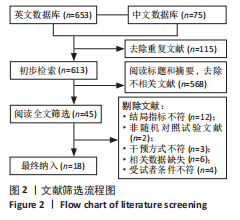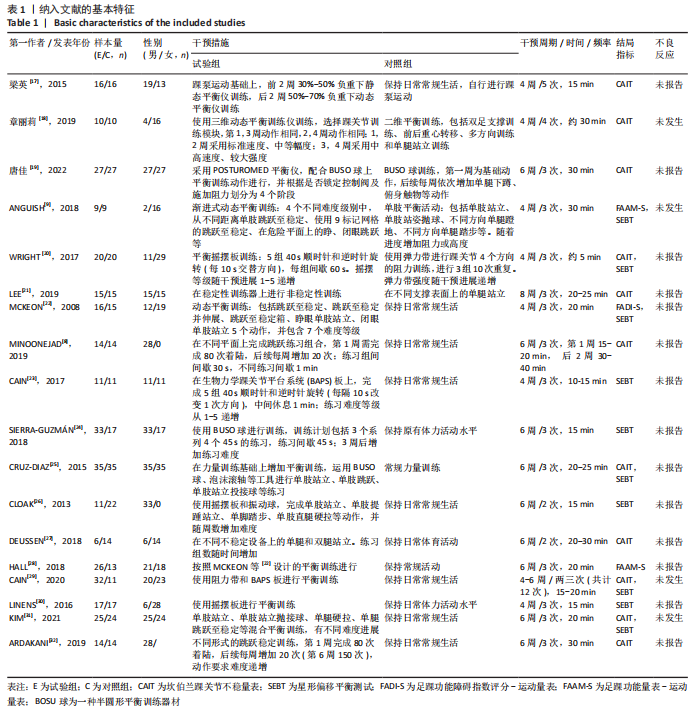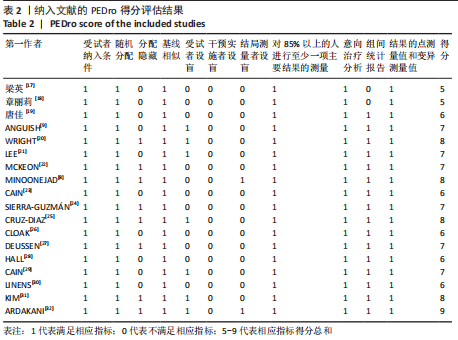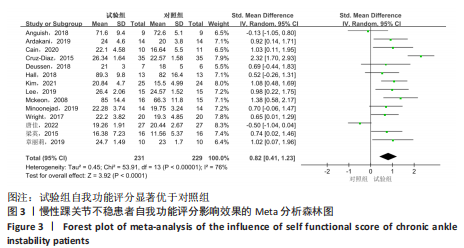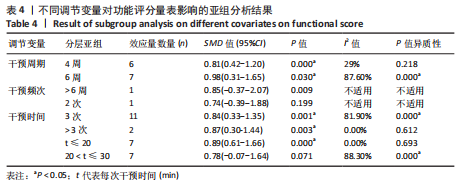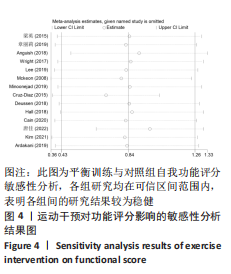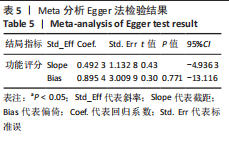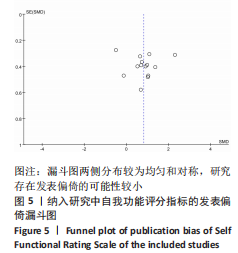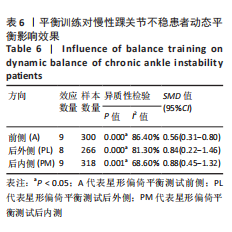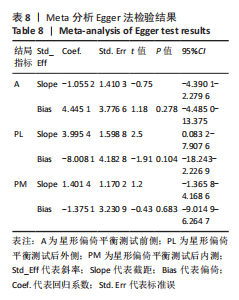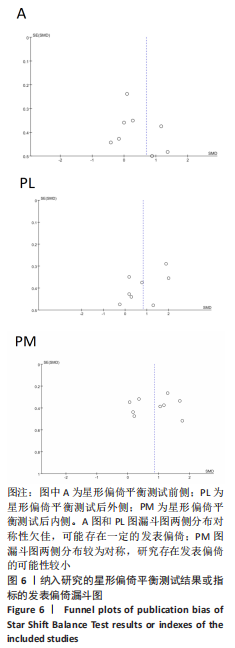Chinese Journal of Tissue Engineering Research ›› 2024, Vol. 28 ›› Issue (24): 3930-3936.doi: 10.12307/2024.094
Effect of balance training on chronic ankle instability: a meta-analysis
Wang Yuetong1, Peng Liang2, Su Yuying2, 3, Liu Jiajun3
- 1College of Education, Beijing Sport University, Beijing 100086, China; 2Physical Education College, Bohai University, Jinzhou 121013, Liaoning Province, China; 3School of Strength and Conditioning Training, Beijing Sport University, Beijing 100086, China
-
Received:2023-05-30Accepted:2023-07-04Online:2024-08-28Published:2023-11-22 -
Contact:Su Yuying, PhD, Physical Education College, Bohai University, Jinzhou 121013, Liaoning Province, China; School of Strength and Conditioning Training, Beijing Sport University, Beijing 100086, China -
About author:Wang Yuetong, Doctoral candidate, College of Education, Beijing Sport University, Beijing 100086, China -
Supported by:2022 Basic Scientific Research Project of Liaoning Provincial Department of Education -- Youth Project, No. LJKQR20222558 (to SYY)
CLC Number:
Cite this article
Wang Yuetong, Peng Liang, Su Yuying, Liu Jiajun. Effect of balance training on chronic ankle instability: a meta-analysis[J]. Chinese Journal of Tissue Engineering Research, 2024, 28(24): 3930-3936.
share this article
Add to citation manager EndNote|Reference Manager|ProCite|BibTeX|RefWorks

2.5.2 调节变量亚组检验结果 通过设置调节变量对3个方向的效应量进行亚组分析发现,见表7。在干预周期方面,6周干预对3个方向均有显著改善效果并且后外侧和后内侧方向达到了大效应量。4周干预中后外侧方向无显著效果,前侧和后内侧方向达到中等效应量。在干预时间方面,小于20 min的干预时间对前侧方向有改善效果,但对后外侧和后内侧方向无改善。20-30 min的干预时间对后内侧和后外侧方向有改善效果且达到大效应量,但对前侧方向无改善作用。在干预频次方面,纳入的文献均为每周干预3次,故不作亚组检验。综上所述,通过平衡训练进行6周干预、每周干预3次,每次干预20-30 min是改善慢性踝关节不稳患者动态平衡能力的最佳组合方案。该研究纳入3个方向的文献均低于10篇,故不对其进行敏感性分析。"
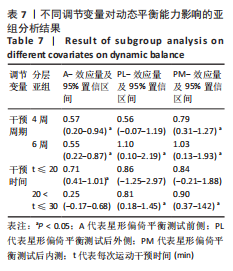
| [1] DOHERTY C, DELAHUNT E, CAULFIELD B, et al. The incidence and prevalence of ankle sprain injury: a systematic review and meta-analysis of prospective epidemiological studies. Sports Med. 2014;44(1):123-140. [2] YEUNG MS, CHAN KM, SO CH, et al. An epidemiological survey on ankle sprain. Br J Sports Med. 1994;28(2):112-116. [3] DELAHUNT E, COUGHLAN GF, CAULFIELD B, et al. Inclusion criteria when investigating insufficiencies in chronic ankle instability. Med Sci Sports Exerc. 2010;42(11):2106-2121. [4] 施晓剑,韩甲,刘宇,等.慢性踝关节不稳的病理机制和评估诊断研究进展[J].中国运动医学杂志,2019,38(9):816-824. [5] 苏应军,童新延,胡力.以踝关节解剖结构及生物力学特征分析慢性踝关节不稳[J].中国组织工程研究,2015,19(15):2415-2419. [6] 章丽莉,杨玉珊,郑洁皎.慢性踝关节不稳姿势稳定性的研究进展[J].中国康复理论与实践,2019,25(8):908-912. [7] TAUBE W, GRUBER M, GOLLHOFER A. Spinal and supraspinal adaptations associated with balance training and their functional relevance. Acta Physiol (Oxf). 2008;193(2):101-116. [8] MINOONEJAD H, KARIMIZADEH ARDAKANI M, RAJABI R, et al. Hop stabilization training improves neuromuscular control in college basketball players with chronic ankle instability: a randomized controlled trial. J Sport Rehabil. 2019;28(6):576-583. [9] ANGUISH B, SANDREY MA. Two 4-week balance-training programs for chronic ankle instability. J Athl Train. 2018;53(7):662-671. [10] MOLLÀ-CASANOVA S, INGLÉS M, SERRA-AÑÓ P. Effects of balance training on functionality, ankle instability, and dynamic balance outcomes in people with chronic ankle instability: systematic review and meta-analysis. Clin Rehabil. 2021;35(12):1694-1709. [11] JIANG C, HUANG DB, LI XM, et al. Effects of balance training on dynamic postural stability in patients with chronic ankle instability: systematic review and meta-analysis of randomized controlled trials. J Sports Med Phys Fitness. 2022;62(12):1707-1715. [12] 高淑青,王晓晨,张连成.循证锻炼在大众锻炼实践领域的应用思考[J].体育学刊, 2022,29(3):139-144. [13] 苏玉莹,尹洪满,石旅畅,等.飞轮离心超负荷训练对预防模拟失重人群废用性肌萎缩效果的meta分析[J].中国康复医学杂志, 2022,37(2):224-230. [14] DE VRIES JS, KRIPS R, SIEREVELT IN, et al. Interventions for treating chronic ankle instability. Cochrane Database Syst Rev. 2011; (8):CD004124. [15] MAHER CG, SHERRINGTON C, HERBERT RD, et al. Reliability of the PEDro scale for rating quality of randomized controlled trials. Phys Ther. 2003;83(8):713-721. [16] 刘鸣.系统评价、Meta-分析设计与实施方法[M].北京:人民卫生出版社,2011:158-164. [17] 梁英,高敏,王萍芝,等.动静态平衡训练治疗慢性踝关节不稳的疗效研究[J].中华老年骨科与康复电子杂志,2015,1(2):23-28. [18] 章丽莉.三维和二维动态平衡训练对功能性踝关节不稳者姿势控制的影响[D].上海:上海体育学院,2019. [19] 唐佳.两种平衡训练对功能性踝关节不稳患者稳定性影响的研究[D].天津:天津体育学院,2022. [20] WRIGHT CJ, LINENS SW, CAIN MS. A randomized controlled trial comparing rehabilitation efficacy in chronic ankle instability. J Sport Rehabil. 2017;26(4):238-249. [21] LEE E, CHO J, LEE S. Short-foot exercise promotes quantitative somatosensory function in ankle instability: a randomized controlled trial. Med Sci Monit. 2019;25: 618-626. [22] MCKEON PO, INGERSOLL CD, KERRIGAN DC, et al. Balance training improves function and postural control in those with chronic ankle instability. Med Sci Sports Exerc. 2008; 40(10):1810-1819. [23] CAIN MS, GARCEAU SW, LINENS SW. Effects of a 4-week biomechanical ankle platform system protocol on balance in high school athletes with chronic ankle instability. J Sport Rehabil. 2017;26(1):1-7. [24] SIERRA-GUZMÁN R, JIMÉNEZ-DIAZ F, RAMÍREZ C, et al. Whole-body-vibration training and balance in recreational athletes with chronic ankle instability. J Athl Train. 2018;53(4): 355-363. [25] CRUZ-DIAZ D, LOMAS-VEGA R, OSUNA-PÉREZ MC, et al. Effects of 6 weeks of balance training on chronic ankle instability in athletes: a randomized controlled trial. Int J Sports Med. 2015;36(9):754-760. [26] CLOAK R, NEVILL A, DAY S, et al. Six-week combined vibration and wobble board training on balance and stability in footballers with functional ankle instability. Clin J Sport Med. 2013;23(5):384-391. [27] DEUSSEN S, ALFUTH M. The influence of sensorimotor training modalities on balance, strength, joint function, and plantar foot sensitivity in recreational athletes with a history of ankle sprain: a randomized controlled pilot study. Int J Sports Phys Ther. 2018;13(6):993-1007. [28] HALL EA, CHOMISTEK AK, KINGMA JJ, et al. Balance- and strength-training protocols to improve chronic ankle instability deficits, part II: assessing patient-reported outcome measures. J Athl Train. 2018;53(6):578-583. [29] CAIN MS, BAN RJ, CHEN YP, et al. Four-week ankle-rehabilitation programs in adolescent athletes with chronic ankle instability. J Athl Train. 2020;55(8):801-810. [30] LINENS SW, ROSS SE, ARNOLD BL. Wobble board rehabilitation for improving balance in ankles with chronic instability. Clin J Sport Med. 2016;26(1):76-82. [31] KIM KM, ESTUDILLO-MARTÍNEZ MD, CASTELLOTE-CABALLERO Y, et al. Short-term effects of balance training with stroboscopic vision for patients with chronic ankle instability: a single-blinded randomized controlled trial. Int J Environ Res Public Health. 2021;18(10):5364. [32] ARDAKANI MK, WIKSTROM EA, MINOONEJAD H, et al. Hop-stabilization training and landing biomechanics in athletes with chronic ankle instability: a randomized controlled trial. J athl train. 2019;54(12):1296-1303. [33] 尹彦,罗冬梅,刘卉,等.功能性踝关节不稳的机制与自评量表的研究进展[J].中国康复理论与实践,2018,24(6):671-677. [34] LOUDON JK, SANTOS MJ, FRANKS L, et al. The effectiveness of active exercise as an intervention for functional ankle instability: a systematic review. Sports Med. 2008;38(7): 553-563. [35] 尹金玲,王松,熊禄全,等.整合性神经肌肉训练对运动员运动表现影响的Meta分析[J].武汉体育学院学报,2021,55(10):77-85. [36] 魏智丰,王子朴,杜承润,等.平衡能力训练在下肢运动损伤预防及康复中的应用研究[J].中国体育科技,2022,58(10):9-13. [37] ERGEN E, ULKAR B. Proprioception and ankle injuries in soccer. Clin Sports Med. 2008; 27(1):195-217. [38] DE VASCONCELOS GS, CINI A, SBRUZZI G, et al. Effects of proprioceptive training on the incidence of ankle sprain in athletes: systematic review and meta-analysis. Clin Rehabil. 2018;32(12):1581-1590. [39] NAGANO Y, IDA H, AKAI M, et al. Effects of jump and balance training on knee kinematics and electromyography of female basketball athletes during a single limb drop landing: pre-post intervention study. Sports Med Arthrosc Rehabil Ther Technol. 2011;3(1):14. [40] SHAMSEDDINI SOFLA F, HADADI M, REZAEI I, et al. The effect of the combination of whole body vibration and shoe with an unstable surface in chronic ankle instability treatment: a randomized clinical trial. BMC Sports Sci Med Rehabil. 2021;13(1):28. [41] YOUSSEF NM, ABDELMOHSEN AM, ASHOUR AA, et al. Effect of different balance training programs on postural control in chronic ankle instability: a randomized controlled trial. Acta Bioeng Biomech. 2018;20(2):159-169. [42] O’DRISCOLL J, DELAHUNT E. Neuromuscular training to enhance sensorimotor and functional deficits in subjects with chronic ankle instability: a systematic review and best evidence synthesis. Sports Med Arthrosc Rehabil Ther Technol. 2011;3:19. [43] 刘展.人体动作模式和运动链的理念在运动损伤防护和康复中的应用[J].成都体育学院学报,2016,42(6):1-11. |
| [1] | Zhong Jun, Wang Wen. Network meta-analysis of different anatomical repair strategies to improve chronic lateral ankle instability [J]. Chinese Journal of Tissue Engineering Research, 2024, 28(9): 1470-1476. |
| [2] | Zhang Xihui, Li Zhengrong, Li Shineng, Xing Zengyu, Wang Jiao. Effect of rehabilitation training guided by Pro-kin balance system on proprioception and balance function of the affected knee after anterior cruciate ligament reconstruction [J]. Chinese Journal of Tissue Engineering Research, 2024, 28(8): 1259-1264. |
| [3] | Ma Shuwei, He Sheng, Han Bing, Zhang Liaoyun. Exosomes derived from mesenchymal stem cells in treatment of animals with acute liver failure: a meta-analysis [J]. Chinese Journal of Tissue Engineering Research, 2024, 28(7): 1137-1142. |
| [4] | Zheng Jiafa, Song Xiufeng, Li Hongzhi, Zhou Jinming, Guan Shengyi, Yu He. Open reduction and internal fixation via the para-Achilles tendon approach for the treatment of posterior malleolus sandwich fractures [J]. Chinese Journal of Tissue Engineering Research, 2024, 28(6): 934-938. |
| [5] | Zhang Zeyi, Yang Yimin, Li Wenyan, Zhang Meizhen. Effect of foot progression angle on lower extremity kinetics of knee osteoarthritis patients of different ages: a systematic review and meta-analysis [J]. Chinese Journal of Tissue Engineering Research, 2024, 28(6): 968-975. |
| [6] | Hu Zhixing, Li Qun, Yang Chao, Wang Xiaoxiao, Fang Luochangting, Hou Wuqiong, Lin Na, Chen Weiheng, Liu Chunfang, Lin Ya. Network meta-analysis of the modeling effects of different factors on rabbit models of steroid-induced osteonecrosis of femoral head [J]. Chinese Journal of Tissue Engineering Research, 2024, 28(6): 976-984. |
| [7] | Yu Zhaoyu, Tan Lixin, Sun Kai, Lu Yao, Li Yong. Meta-analysis of cement-augmented pedicle screw for thoracolumbar degenerative diseases with osteoporosis [J]. Chinese Journal of Tissue Engineering Research, 2024, 28(5): 813-820. |
| [8] | Abuduwupuer·Haibier, Alimujiang·Yusufu, Maihemuti·Yakufu, Maimaitimin·Abulimiti, Tuerhongjiang·Abudurexiti. Meta-analysis of efficacy and safety of terlipatide and bisphosphate in the treatment of postmenopausal osteoporosis fractures [J]. Chinese Journal of Tissue Engineering Research, 2024, 28(4): 639-645. |
| [9] | Bai Xiaotian, Chen Zhaoying, Song Yiling, Wang Ye, Liu Jingmin. Effect of minimalist shoes on foot muscle morphology: systematic evaluation and Meta-analysis [J]. Chinese Journal of Tissue Engineering Research, 2024, 28(4): 646-650. |
| [10] | Wang Juan, Wang Ling, Zuo Huiwu, Zheng Cheng, Wang Guanglan, Chen Peng. Rehabilitative efficacy of kinesio taping following anterior cruciate ligament reconstruction: a Meta-analysis [J]. Chinese Journal of Tissue Engineering Research, 2024, 28(4): 651-656. |
| [11] | Wang Chunhong, Lu Ming. Universal stepwise rehabilitation training promotes the functional recovery of quadriceps femoris after intertrochanteric femoral fracture surgery [J]. Chinese Journal of Tissue Engineering Research, 2024, 28(26): 4216-4220. |
| [12] | Xu Chenghan, Zhuo Hanjie, Chai Xubin, Huang Yong, Zhang Bowen, Chen Qin, Hao Yupeng, Li Lin, Zhou Yingjie. Meta-analysis of the incidence and related factors for cervical spine instability in patients with rheumatoid arthritis [J]. Chinese Journal of Tissue Engineering Research, 2024, 28(24): 3922-3929. |
| [13] | Dong Kuan, Xu Chengli, Tian Jing, Xu Changchun. Effects of endurance training with blood flow restriction on aerobic capacity, lower limb muscle strength, and sports performance: a Meta-analysis [J]. Chinese Journal of Tissue Engineering Research, 2024, 28(23): 3766-3772. |
| [14] | Feng Liang, Zhang Yafei, Huo Hongfeng. Measurement and evaluation of proprioception of foot and ankle complexes [J]. Chinese Journal of Tissue Engineering Research, 2024, 28(20): 3259-3264. |
| [15] | Chang Wanpeng, Zhang Zhongwen, Yang Yulin, Zi Yang, Yang Mengqi, Du Bingyu, Wang Nan, Yu Shaohong. Efficacy of rehabilitation exoskeleton robots on post-stroke lower limb motor dysfunction: a Meta-analysis [J]. Chinese Journal of Tissue Engineering Research, 2024, 28(2): 321-328. |
| Viewed | ||||||
|
Full text |
|
|||||
|
Abstract |
|
|||||

